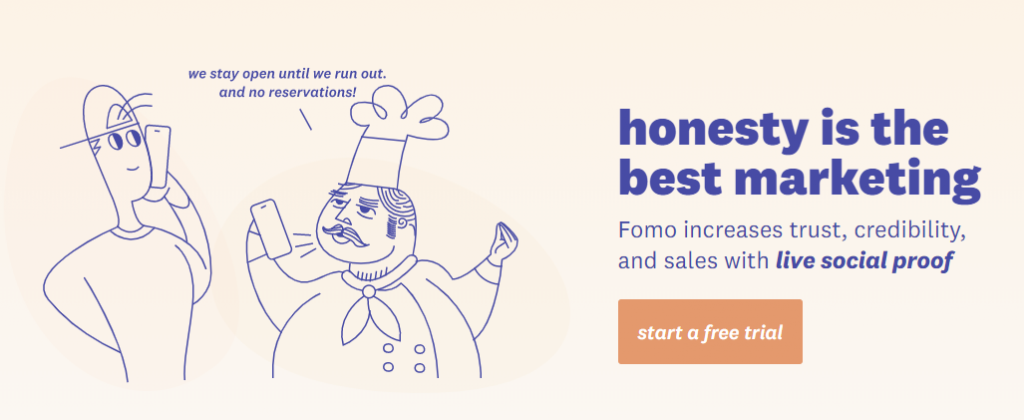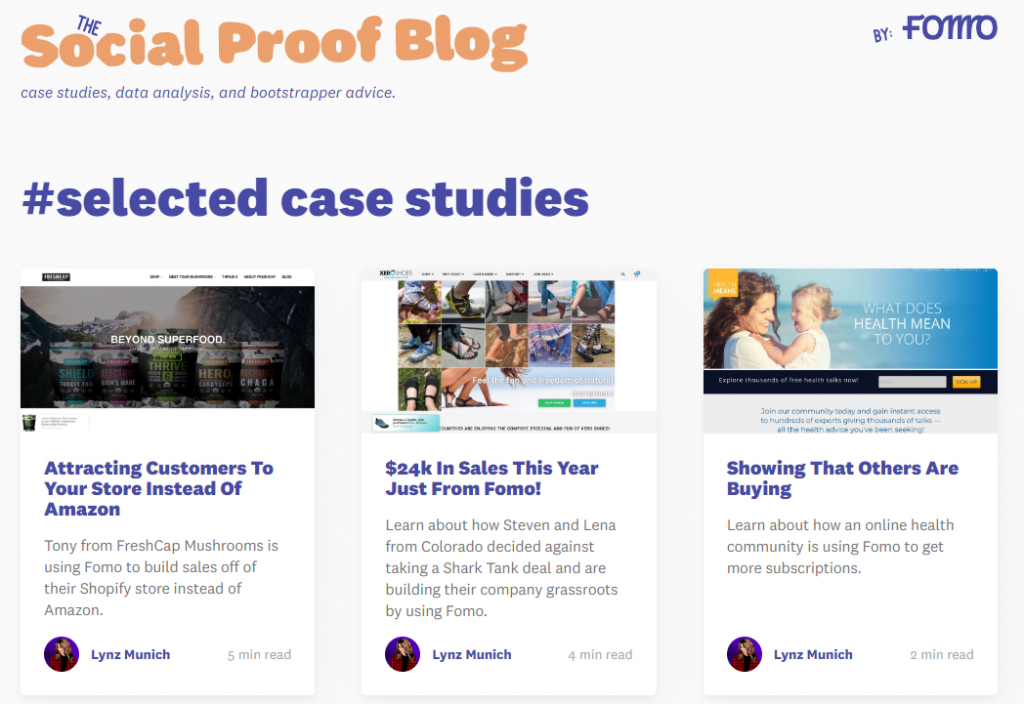Lynz Munich creates four case studies per month for Fomo—many of which lack hard numbers. Here’s how and why she does it.
When kicking off a new case study, a lack of success metrics is one of the biggest barriers to entry:
- “We don’t track X.”
- “My customer doesn’t measure their results.”
- “We can’t share these results publicly.”
We hear these concerns all the time.
In the minds of some, insufficient metrics kill a good success story before it’s even begun. But savvy marketers know better. Hard numbers are great, but in their absence, a compelling customer journey and an emotional story that resonates with target readers can have just as big of an impact.
At Case Study Buddy, we’ve made a point of mastering the art of writing metric-less case studies.
But we’re not the only ones who understand their value.
Lynz Munich, Content Marketer at Fomo, creates up to four new case studies each and every month—and many of them are metric-less. In this article, we’ll discuss how Fomo cultivated a library of 100+ case studies and why metric-less case studies are so important to Fomo and its customers.
Meet Fomo
Fomo is a marketing plugin for e-commerce websites that displays a live stream of notifications about purchases, new subscribers, current page views, and more. Even websites that don’t sell products can use Fomo to great effect: generating brand awareness, streamlining the user journey, and aggregating powerful social proof—no coding required.

The power of metric-less case studies
Fomo customers love the product, and many have amazing results to share about how it helps them increase conversions and sales. But other customers use Fomo in different capacities: encouraging email signups, creating urgency, building trust, etc.
These customers also love the product—and have equally amazing experiences to share—but they often lack the analytics to measure exactly how Fomo impacted revenue or conversions.
At first, Lynz thought the only stories they were able to tell were those accompanied by impressive stats. But as she started creating case study after case study, she had an epiphany:
“Stats are nice, but results aren’t the only thing prospects are looking for. They also want to understand how different customers use Fomo. What it integrates with. What our support team is like. Numbers don’t tell the whole story.”
Compelling metrics are certainly eye-catching, and they definitely appeal to a certain kind of customer. But for a company like Fomo, that works with businesses of all sizes and scales, there’s no such thing as a “one-size-fits-all” case study that engages every lead and prospect equally.
“At the end of the day, Fomo was designed to help people add transparency to their business. It soon became evident that telling a good story was more important than highlighting an impressive stat.”
Many businesses fall into the trap of over-prioritizing results metrics. They wind up ignoring amazing, human stories in reckless pursuit of the biggest numbers. What do they have to show for it? Generic case studies that don’t communicate anything new. If you’ve read one, you’ve read them all.
Fomo wanted to sidestep that pitfall. As Lynz interviewed more and more customers, she got a taste of the wide array of reasons people use Fomo. She realized that case studies don’t need to all look the same or focus on the same benefits—they just need to connect with readers.
“What do you trust more: a movie trailer that claims some critic you’ve never heard of gave it a 9/10, or a movie that comes highly recommended by a personal friend? You trust your friend. Case studies work the same way—a great, relatable story that hits you personally is more effective than a hard number.”
“It soon became evident that telling a good story was more important than highlighting an impressive stat.”
Lynz Munich, Fomo
How Fomo leverages its 100+ case studies
When asked if social proof has had an impact on Fomo and its overall business, Lynz smiles wryly and asks: Would you trust a social proof company that doesn’t have strong social proof?
She doesn’t need to say the answer.
The Fomo brand is built on the policy that “honesty is the best marketing.” They practice what they preach—and love showing off the honest responses from their many satisfied customers. They turn some of these responses into case studies, and they leverage these customer success stories in three main ways:
1. Curated testimonials on the website
Want to be overwhelmed by positive social proof? Go visit Fomo’s “reviews” and take a look at the wide variety of different companies that have benefited from the plugin. Every other testimonial includes a link to a full case study that dives deeper into who the customer is, what their goal was, and how Fomo helped. Lynz says that having this 1-2 punch of testimonial and case study helps establish trust:
“When people see a testimonial on a website, there’s room for skepticism—is this a real person? Did they really say that? When you link your testimonial to a full case study, there’s no more room for doubt—you get to connect to that customer and live their experience for a few minutes.”
2. Case studies published on the blog
Fomo has an entire blog dedicated to social proof. Explore #selected case studies and you’ll be treated to a cornucopia of Q&A-style case studies that Lynz is adding to every single week.

The case studies celebrate everything from enterprise-level businesses to start-ups, and they cover everything from concrete monetary wins to the aforementioned metric-less success stories. Lynz says:
“We like the Q&A format because it lets us hear directly from our customers. It gives them a platform to talk about how they’re using Fomo with no strings attached and it creates a deeply personal story.”
3. Newsletter content
Fomo’s newsletter has over 35,000 subscribers—and one of the things they love hearing about most is how other people just like them are using Fomo to grow their business and build customer trust. That’s why, whenever Lynz has another new case study hot off the press, one of the first things she does is share it in the newsletter. She explains:
“We feature case studies in our newsletter. The featured customer loves it; it brings a lot of exposure to their business. And I love exploring all of the creative ways people are using our product.”
Why create so many case studies?
Fomo doesn’t just create case studies for the hell of it. There’s a rhyme and a reason behind their relentless pursuit of social proof.
The primary purpose of each case study is to build customer trust, but that’s not all. Many case studies also include a call to action, inviting users to start a free 14-day trial. This small, simple inclusion turns each piece of social proof into a powerful lead magnet.
How Fomo collects and uses customer feedback
So how does a company go from zero case studies to an impressive collection of 100-plus case studies? According to Lynz, it wasn’t hard to get started, and anyone can do it if they try:
- Start with research. Lynz went through Fomo’s database and analyzed customer accounts one by one. She checked who had been using the plug-in the longest, who had the most impressions, who had the most conversions (if they had Google Analytics set up), and who had recently interacted with customer support. Just like that—she had a shortlist of potential case study candidates.
- Contact warm leads. Lynz says, “If you have customers who have had a great interaction with your support team, talk to them. Definitely talk to customers who are already leaving you positive reviews of their own free will—there’s an open door there.”
- Refine your script. The quality of your pre-case study interview can make or break the quality of the story you have to tell. You need to ask the right questions to elicit detailed answers. That’s why Lynz spends a little bit of time every day revisiting her question set and tweaking her messaging.
- Don’t lose the “user” behind your use case. Lynz says, “What makes our case studies so successful is that we’re just featuring the humans behind the business. We’re putting people first, and these stories prove it—they’re all about them.”
- Use your stories to generate more stories. Nowadays, Lynz doesn’t usually need to reach out to warm leads to generate new success stories. Every newsletter includes a call to action inviting people to sign up if they’re interested in being featured in a future case study. After seeing their fellow business-owners get a featured spot, customers are lining up to be included.
Lynz has even leveraged some clever messaging—putting the “fear of missing out” in “Fomo”—to create urgency that makes people even more eager to take part:
“I tell customers, ‘We’d love to feature you. We’d love to tell your success story. But we only create four case studies per month so make sure you put your name in if you’re interested.’”
“Think about the customers you want to attract and the people who are already engaging with your brand. Tell the stories that are important to them.”
Lynz Munich, Fomo
Do your success stories need hard metrics?
At Case Study Buddy, we’re firm believers that compelling results enhance an already great story. An eye-catching hero metric can turn heads and inspire clicks.
But metrics alone don’t make or break a great case study; the story still needs to resonate with your target audience, and the content needs to work together to help you fulfill your case study strategy. In fact, some of our most powerful case studies focus a lot more on solving reader pain points over stressing results metrics.
It’s the same philosophy that Fomo has adopted while creating its 100+ case studies:
“How do you measure customer success? It doesn’t always have to be about metrics and not everything can be measured that way. Think about the customers you want to attract and the people who are already engaging your brand. Tell the stories that are important to them.”
But telling a great story is much, much harder than slapping a success metric onto your website homepage. You need to have the talent to capture the right details in a call, turn an interview into a compelling story, and apply some beautiful design to make sure that it looks as good as it reads.
When all of that is just a bit too much to handle in-house—that’s when you call Case Study Buddy.
We’ll help you turn your biggest wins into your best sales assets.
Contact Case Study Buddy to find out how we can help.